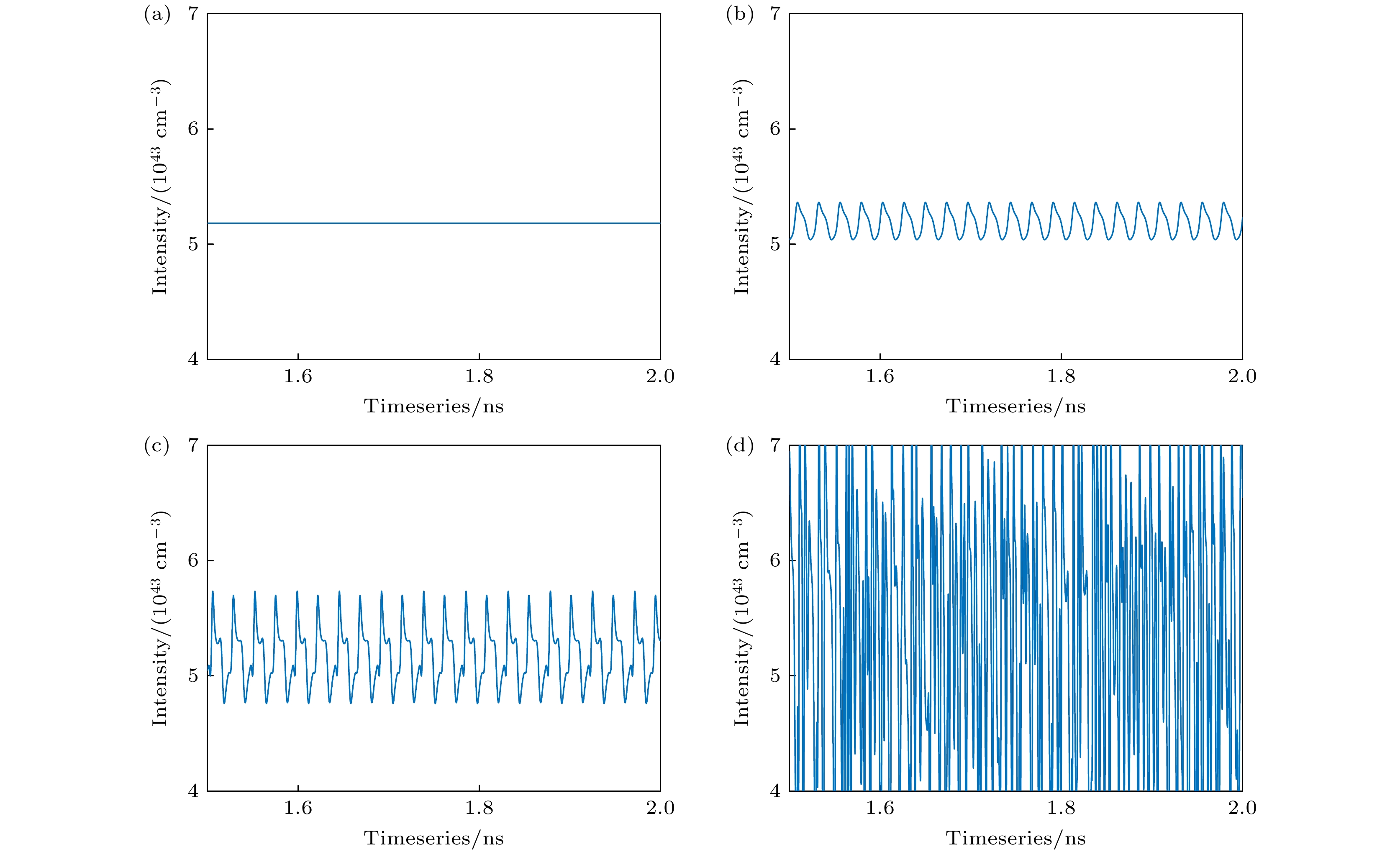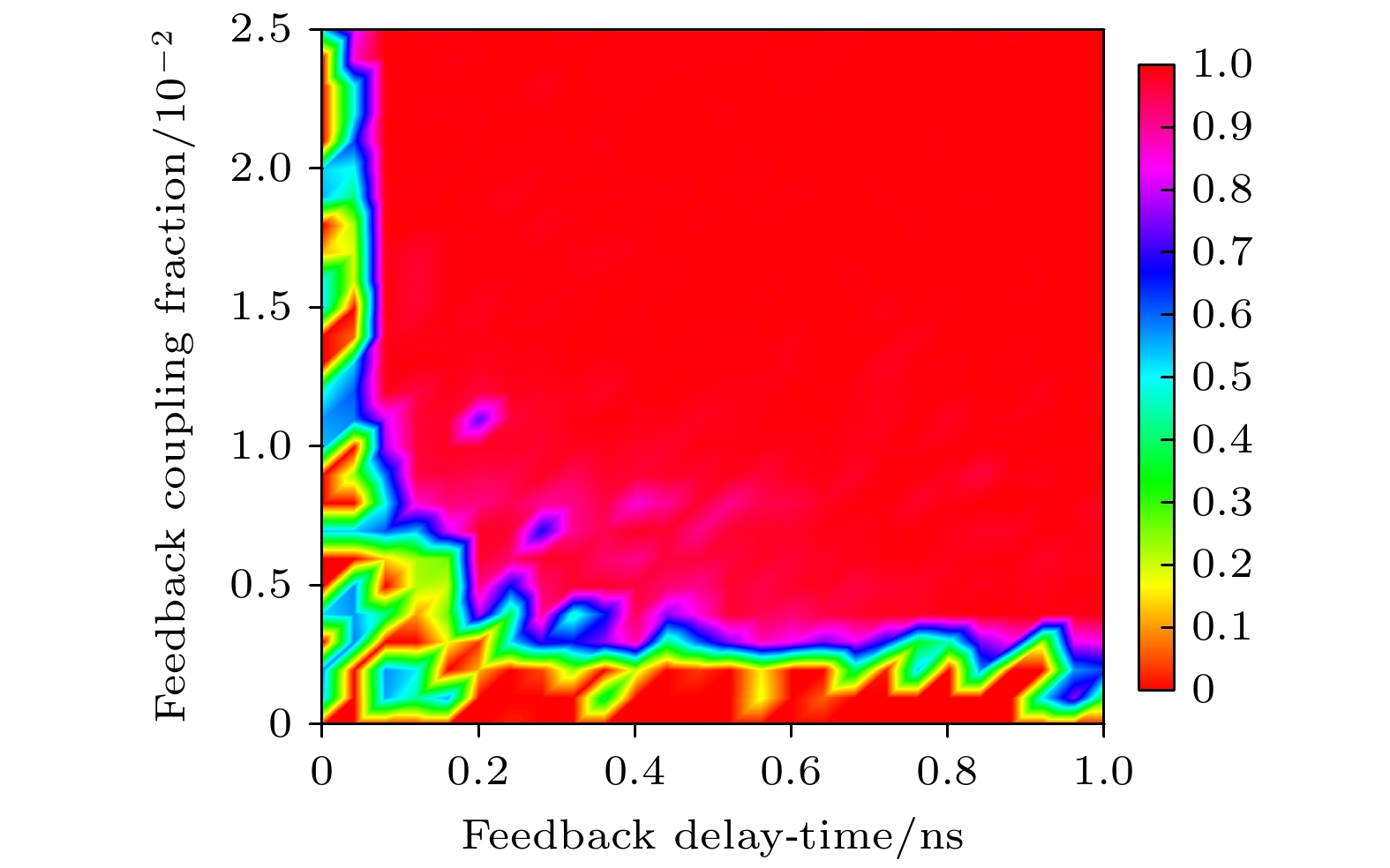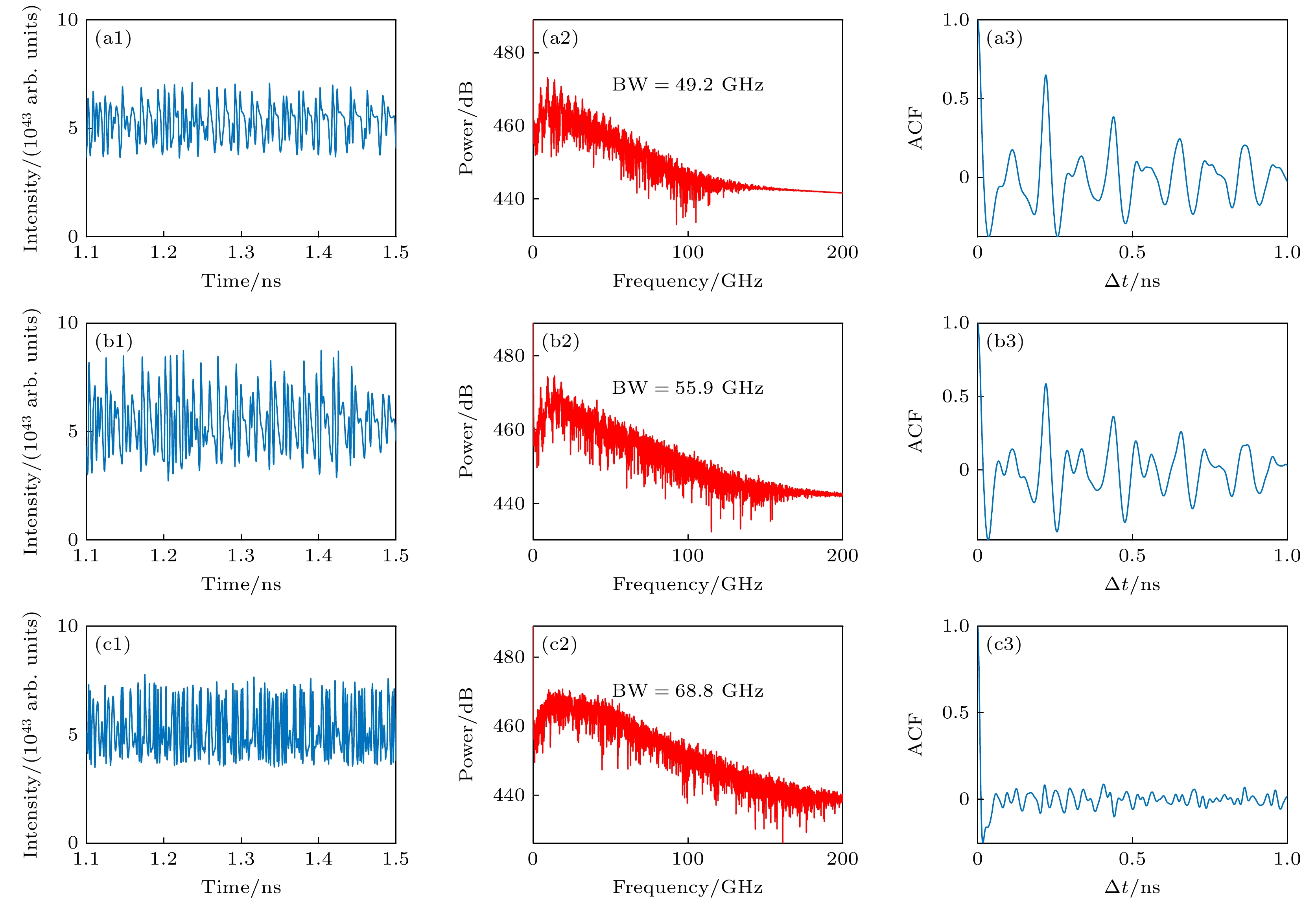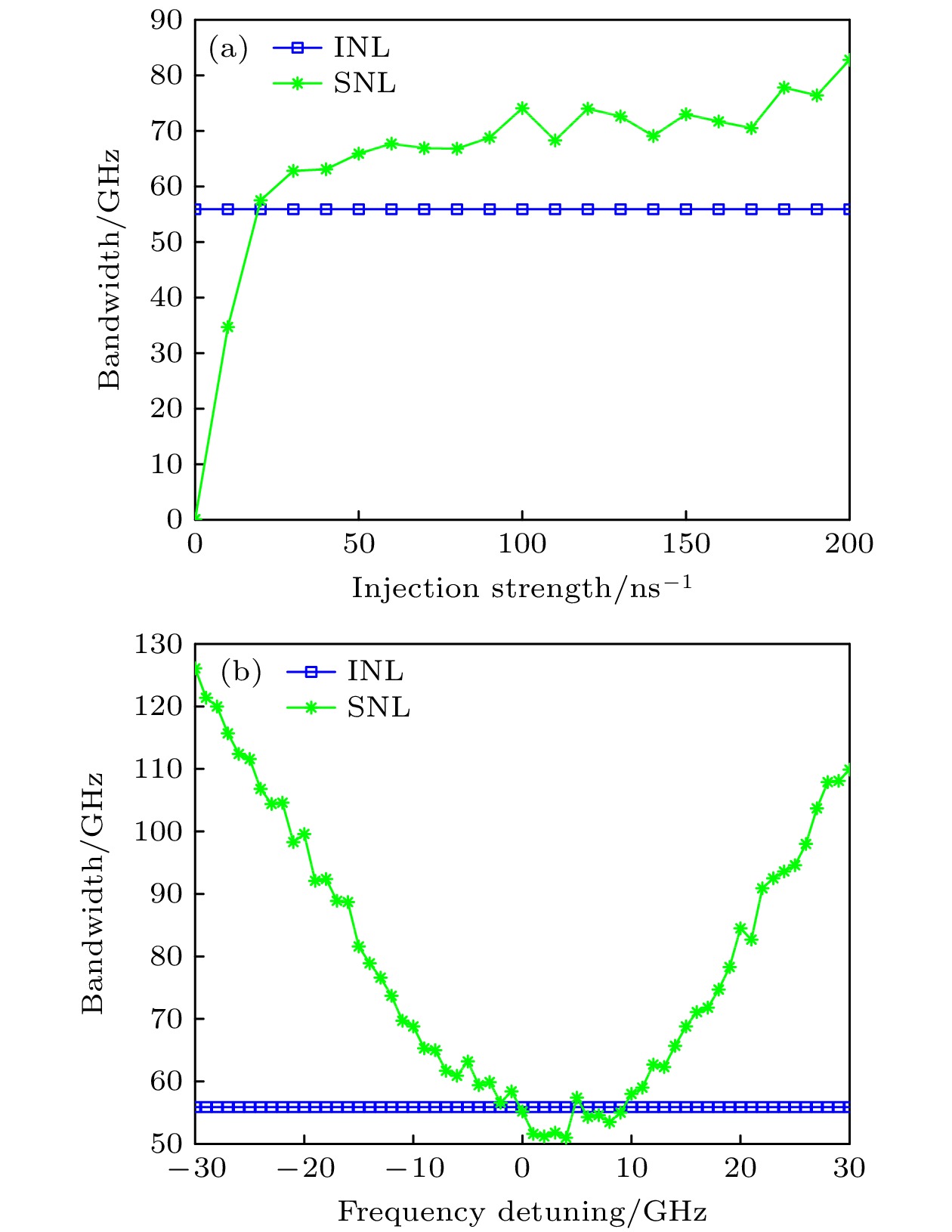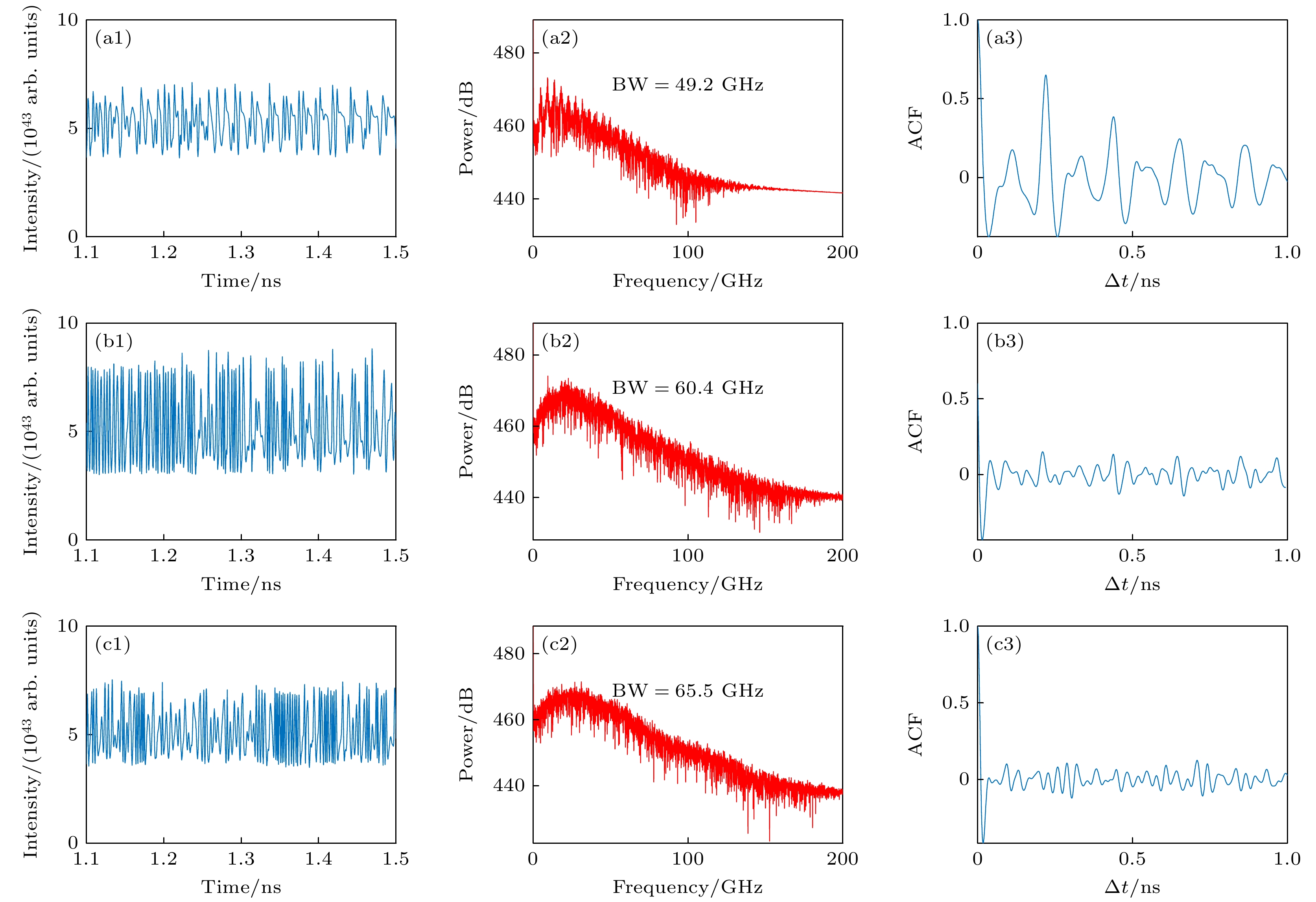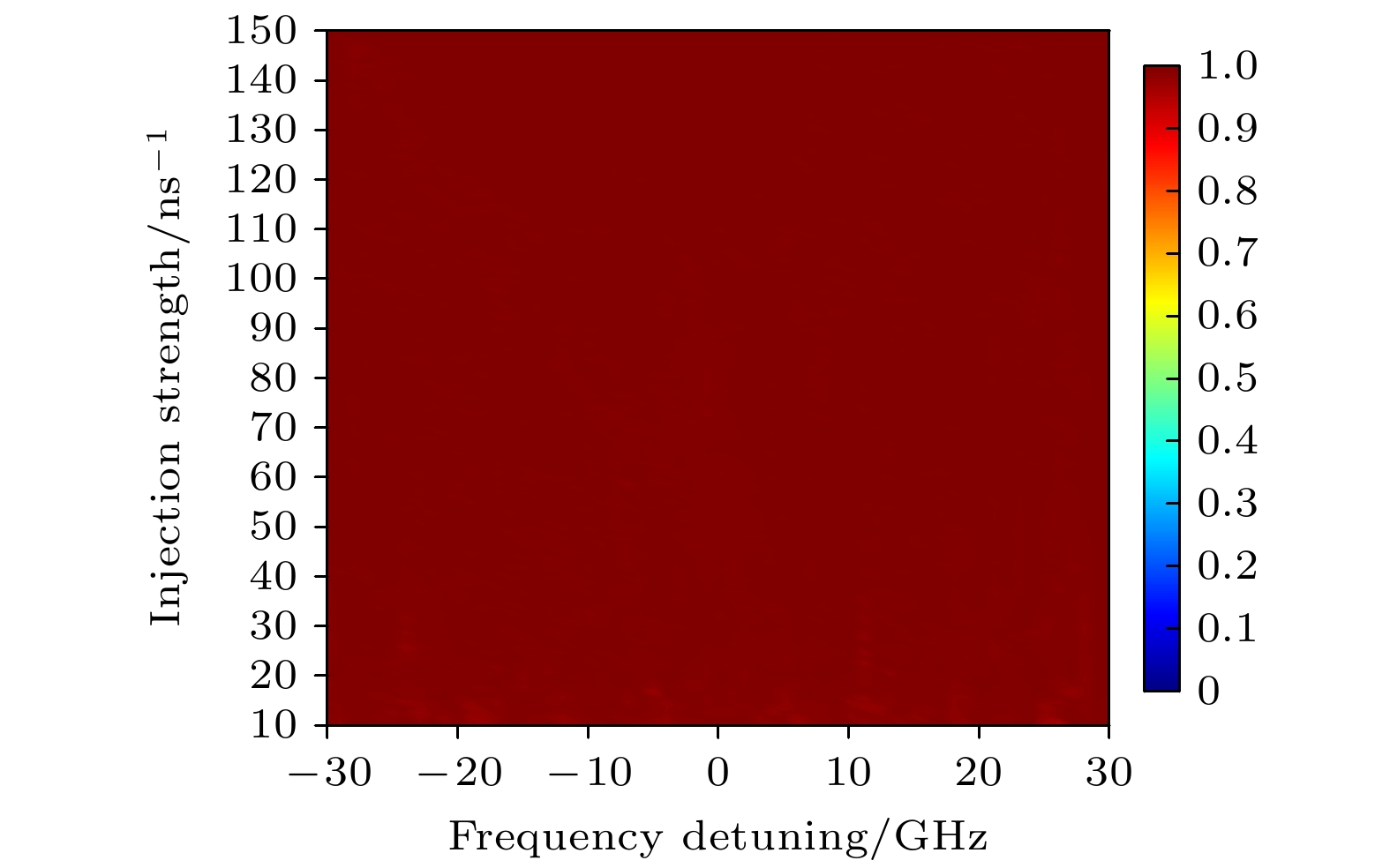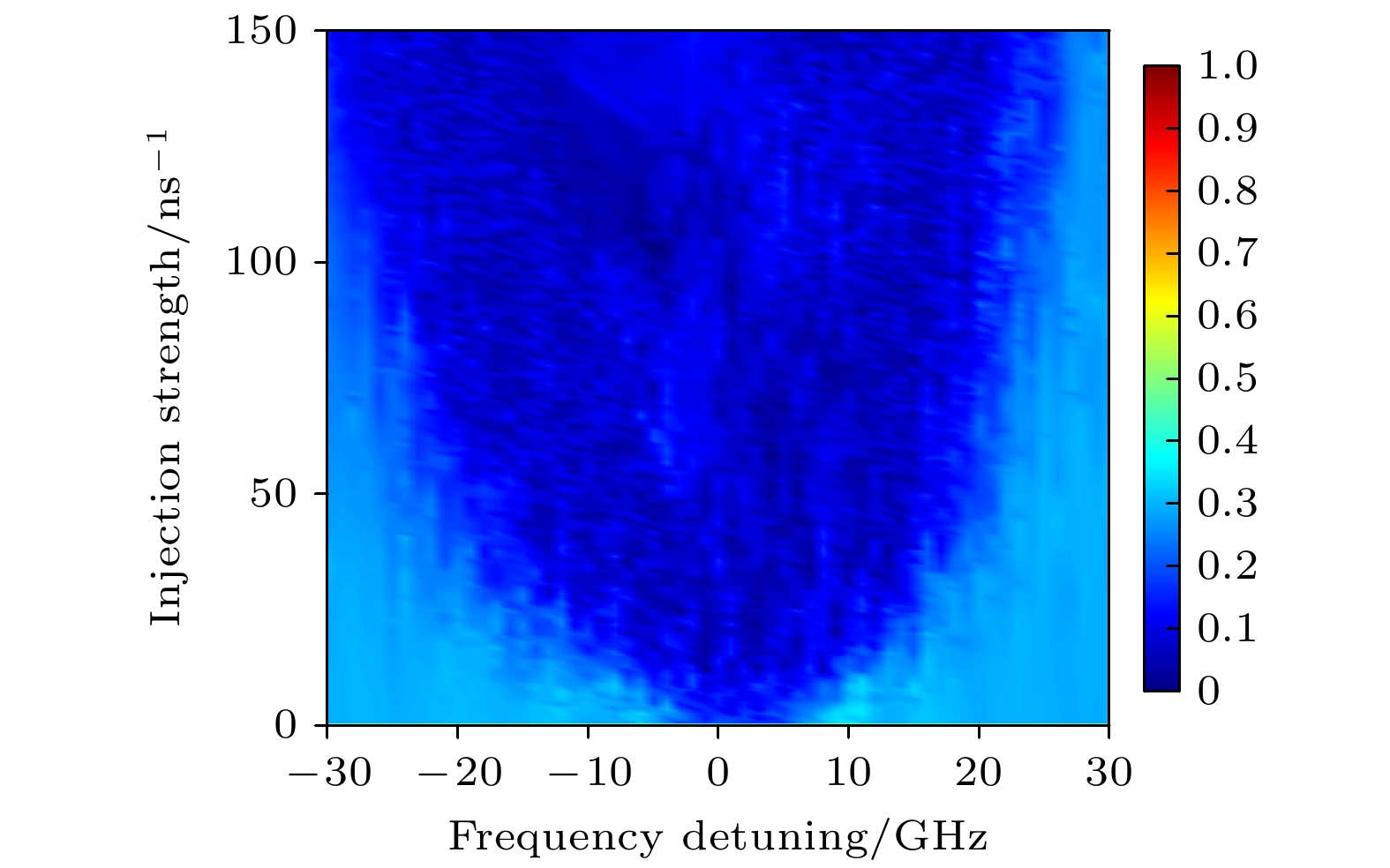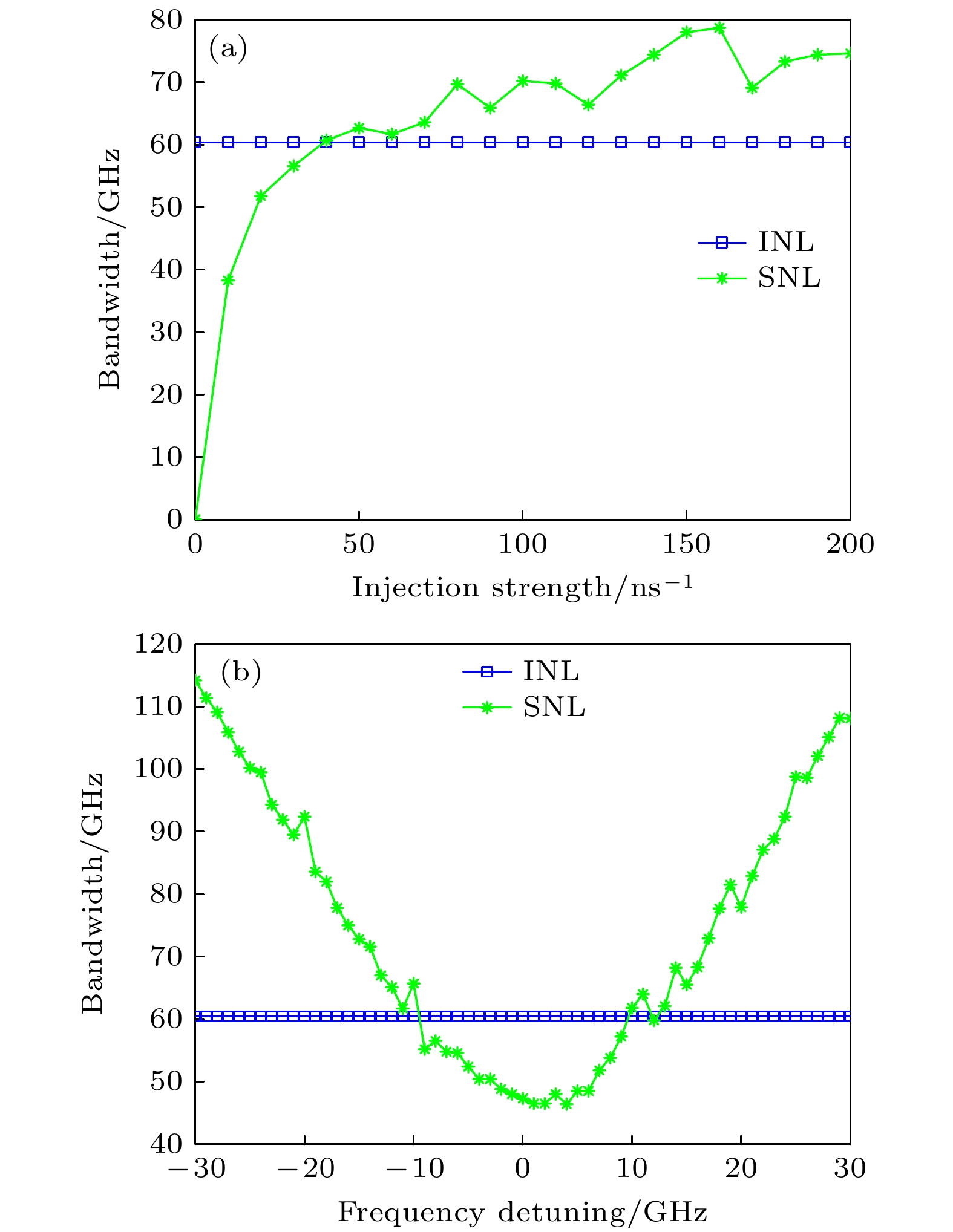-
纳米激光器作为光学源的重要组成部分, 其非线性动力学更是成为近年来研究的热点之一. 本文针对级联耦合纳米激光器系统中时延特征和带宽特性进行了研究. 引入0-1混沌测试对纳米激光器的动力学特性进行了量化, 利用自相关函数分析激光器输出信号中的时延特征. 仿真中, 针对中间纳米激光器是否带有明显时延特征峰的两种情况进行对比分析. 研究结果表明: 选择合适的系统参数, 可以使从纳米激光器始终输出无明显时延特征的宽带混沌信号. 通过改变频率失谐参数使得中间纳米激光器存在明显的时延特征, 此时从纳米激光器可以在较小的参数区间内输出时延抑制及带宽增强的混沌信号, 当中间纳米激光器时延信号完全隐藏时, 从纳米激光器可以在较大的参数平面上实现时延特征的抑制, 同时带宽得到明显展宽. 此外, 还通过绘制频率失谐及注入强度下从纳米激光器输出的二维空间分布图和带宽线图, 确定了纳米激光器在混沌信号下能够同时实现抑制时延特征与带宽增大的较宽参数范围. 这对于实现保密性增强的混沌光通信应用提供了重要理论基础.As an important part of optical sources, nanolasers have a prominent influence in photonic circuit integration, and their nonlinear dynamics has become one of the research hotspots in recent years. In this work, we investigate the time-delay signature and bandwidth characteristics in a cascade-coupled nanolaser system, in which the master nanolaser is connected to an external feedback cavity and injected into the intermediate nanolaser and the slave nanolaser sequentially. The 0-1 chaos test is introduced to quantify the dynamics of the nanolaser, which can accurately distinguish whether the laser is in a chaotic state, and the autocorrelation function is used to analyze the time-delay characteristics in the laser output signal. This type of calculation has the advantages of fast operation speed, high accuracy and anti-noise robustness. The lower the autocorrelation value, the more difficult it is to extract useful information from the chaotic random sequence. The bandwidth is defined as a value where the range between DC and frequency contains 80% of the spectral power, a value that is only applicable to chaotic states. In the simulation, we compare and analyze the two cases of whether the intermediate nanolaser has a peak with obvious time-delay signature. The research results show that by selecting appropriate system parameters, the slave nanolaser can always output a broadband chaotic signal without obvious time-delay signature. Under the condition of a certain injection intensity, by changing the frequency detuning parameter, the intermediate nanolaser has an obvious time-delay signature, and then the slave nano-laser can output chaotic signals which can suppress time-delay signature and enhance bandwidth in a small parameter interval. When the time-delay signal of the intermediate nanolaser is completely hidden, the slave nanolaser can achieve the suppression of the time-delay signature in a larger parameter plane, meanwhile the bandwidth is significantly enhanced. In addition, by plotting the two-dimensional spatial distribution diagram and bandwidth line diagram of the output from the nanolaser under frequency detuning and injection intensity, it is determined that the nanolaser can simultaneously suppress the delay characteristics and enhance the bandwidth under chaotic signals. This provides an important theoretical basis for realizing the practical applications in secrecy-enhanced chaotic optical communication.
-
Keywords:
- nanolaser /
- chaos /
- time delay signature /
- bandwidth
[1] Li N Q, Susanto H, Cemlyn B, Henning I D, Adams M J 2017 Opt. Lett. 42 3494
 Google Scholar
Google Scholar
[2] Li N Q, Pan W, Yan L S, Luo B, Xu M F, Tang Y L, Jiang N, Xiang S Y, Zhang Q 2012 J. Opt. Soc. Am. B 29 101
 Google Scholar
Google Scholar
[3] Lin F Y, Liu J M 2004 IEEE J. Select. Topics Quantum Electron. 10 991
 Google Scholar
Google Scholar
[4] Tsay H L, Wang C Y, Chen J D, Lin F Y 2020 Opt. Express 28 24037
 Google Scholar
Google Scholar
[5] Qin J, Zhao Q C, Xu D J, Yin H X, Chang Y, Huang D G 2016 Mod. Phys. Lett. B 30 1650199
 Google Scholar
Google Scholar
[6] Uchida A, Amano K, Inoue M, et al. 2008 Nat. Photon 2 728
 Google Scholar
Google Scholar
[7] Rasmussen T S, Mork J 2021 Opt. Express 29 14182
 Google Scholar
Google Scholar
[8] Simpson T B, Liu J M, Gavrielides A, Kovanis V, Alsing P M 1995 Phys. Rev. A 51 4181
 Google Scholar
Google Scholar
[9] Zhang Y, Chen Q, Li S, Yu J, Xu H, Yin F, Dai Y, Xu K 2023 2023 21st International Conference on Optical Communications and Networks (ICOCN) Qufu, China, 2023-07-31 pp1–3
[10] Wu J G, Xia G Q, Tang X, Lin X D, Deng T, Fan L, Wu Z M 2010 Opt. Express 18 6661
 Google Scholar
Google Scholar
[11] Jafari A, Sedghi H, Mabhouti K, Behnia S 2011 Opt. Commun. 284 3018
 Google Scholar
Google Scholar
[12] Udaltsov V S, Goedgebuer J P, Larger L, Cuenot J B, Levy P, Rhodes W T 2003 Phys. Lett. A 308 54
 Google Scholar
Google Scholar
[13] Tartwijk jk G H M V, Lenstra D 1995 Quantum Semiclass. Opt. 7 87
 Google Scholar
Google Scholar
[14] Vicente R, Daudén J, Colet P, Toral R 2005 IEEE J. Quantum Electron. 41 541
 Google Scholar
Google Scholar
[15] Jiang N, Wang Y J, Zhao A K, Liu S Q, Zhang Y Q, Chen L, Li B C, Qiu K 2020 Opt. Express 28 1999
 Google Scholar
Google Scholar
[16] Zhao Q C, Wang Y C, Wang A B 2009 Appl. Opt. 48 3515
 Google Scholar
Google Scholar
[17] Rontani D, Locquet A, Sciamanna M, Citrin D S 2007 Opt. Lett. 32 2960
 Google Scholar
Google Scholar
[18] Wu J G, Xia G Q, Wu Z M 2009 Opt. Express 17 20124
 Google Scholar
Google Scholar
[19] Sakuraba R, Kanno K, Iwakawa K, Uchida A 2013 Frontiers in Optics Orlando, Florida, 2013 pFM3C.4
[20] Hong Y, Quirce A, Wang B, Ji S, Panajotov K, Spencer P S 2016 IEEE J. Quantum Electron. 52 2400508
 Google Scholar
Google Scholar
[21] Mu P H, He P F, Li N Q 2019 IEEE Access 7 11041
 Google Scholar
Google Scholar
[22] Sattar Z A, Shore K A 2015 J. Lightwave Technol. 33 3028
 Google Scholar
Google Scholar
[23] Sattar Z A, Shore K A 2015 IEEE J. Sel. Top. Quantum Electron. 21 1800106
 Google Scholar
Google Scholar
[24] Sattar Z A, Kamel N A, Shore K A 2016 IEEE J. Quantum Electron. 52 1200108
 Google Scholar
Google Scholar
[25] Han H, Shore K A 2016 IEEE J. Quantum Electron. 52 2000306
 Google Scholar
Google Scholar
[26] Elsonbaty A, Hegazy S F, Obayya S S A 2018 Opt. Laser Eng. 107 342
 Google Scholar
Google Scholar
[27] Qu Y, Xiang S Y, Wang Y, Lin L, Wen A J, Hao Y 2019 IEEE J. Quantum Electron. 55 2000407
 Google Scholar
Google Scholar
[28] Sattar Z A, Shore K A 2016 IEEE J. Quantum Electron. 52 1100108
 Google Scholar
Google Scholar
[29] Nguimdo R M, Soriano M C, Colet P 2011 Opt. Lett. 36 4332
 Google Scholar
Google Scholar
[30] Nguimdo R M, Colet P, Larger L, Pesquera L 2011 Phys. Rev. Lett. 107 034103
 Google Scholar
Google Scholar
[31] Rontani D, Locquet A, Sciamanna M, Citrin D, Ortin S 2009 IEEE J. Quantum Electron. 45 879
 Google Scholar
Google Scholar
[32] Priyadarshi S, Hong Y, Pierce I, Shore K A 2013 IEEE J. Sel. Top. Quantum Electron. 19 1700707
 Google Scholar
Google Scholar
[33] Li X F, Pan W, Luo B, Ma D 2006 IEEE J. Quantum Electron. 42 953
 Google Scholar
Google Scholar
[34] Jiang P, Zhou P, Li N Q, Mu P H, Li X F 2020 Opt. Express 28 26421
 Google Scholar
Google Scholar
[35] Gottwald G A, Melbourne I 2009 SIAM J. Appl. Dyn. Syst. 8 129
 Google Scholar
Google Scholar
-
图 4 MNL (a1)—(a3), INL (b1)—(b3)和SNL (c1)—(c3)的时间序列、功率谱和ACF, 参数设置为$ {{\Delta }}{f}_{1} $= 0 GHz, $ {k}_{{\mathrm{i}}{\mathrm{n}}{\mathrm{j}}1} $= 120 ns–1, $ {{{\Delta }}f}_{2} $= 15 GHz和$ {k}_{{\mathrm{i}}{\mathrm{n}}{\mathrm{j}}2} $= 85 ns–1
Fig. 4. Timeseries, power spectrum and ACF of the MNL (a1)–(a3), INL (b1)–(b3) and SNL (c1)–(c3), parameter settings are $ {{\Delta }}{f}_{1} $= 0 GHz, $ {k}_{{\mathrm{i}}{\mathrm{n}}{\mathrm{j}}1} $= 120 ns–1, $ {{{\Delta }}f}_{2} $= 15 GHz and $ {k}_{{\mathrm{i}}{\mathrm{n}}{\mathrm{j}}2} $= 85 ns–1.
图 5 情况1条件下SNL的0-1混沌二维彩图, 参数设置为$ {{\Delta }}{f}_{1} $= 0 GHz, $ {k}_{{\mathrm{i}}{\mathrm{n}}{\mathrm{j}}1} $= 120 ns–1
Fig. 5. Two-dimensional color map of the 0-1 test for chaos of MNL under the condition of case1, parameter settings are $ {{\Delta }}{f}_{1} $= 0 GHz, $ {k}_{{\mathrm{i}}{\mathrm{n}}{\mathrm{j}}1} $= 120 ns–1.
图 6 在情况1的条件下, 参数平面($ {k}_{{\mathrm{i}}{\mathrm{n}}{\mathrm{j}}2} $, $ {{\Delta }}{f}_{2} $)中SNL的TDS值二维图, 参数设置为$ {{\Delta }}{f}_{1} $= 0 GHz, $ {k}_{{\mathrm{i}}{\mathrm{n}}{\mathrm{j}}1} $= 120 ns–1
Fig. 6. Two-dimensional map of TDS value of SNL in the parameter plane ($ {k}_{{\mathrm{i}}{\mathrm{n}}{\mathrm{j}}2} $, $ {{\Delta }}{f}_{2} $) under the condition of case1, parameter settings are $ {{\Delta }}{f}_{1} $= 0 GHz, $ {k}_{{\mathrm{i}}{\mathrm{n}}{\mathrm{j}}1} $= 120 ns–1.
图 7 INL和SNL在不同注入强度和频率失谐下的带宽, 参数设置为$ {{\Delta }}{f}_{1} $= 0 GHz, $ {k}_{{\mathrm{i}}{\mathrm{n}}{\mathrm{j}}1} $= 120 ns–1
Fig. 7. Bandwidth of INL and SNL with different injection strength and frequency detuning, parameter settings are $ {{\Delta }}{f}_{1} $= 0 GHz, $ {k}_{{\mathrm{i}}{\mathrm{n}}{\mathrm{j}}1} $= 120 ns–1.
图 8 MNL (a1)—(a3), INL (b1)—(b3)和SNL (c1)—(c3)的时间序列、功率谱和ACF, 参数设置为$ {{\Delta }}{f}_{1} $= 15 GHz, $ {k}_{{\mathrm{i}}{\mathrm{n}}{\mathrm{j}}1} $= 120 ns–1, $ {{{\Delta }}f}_{2} $= 15 GHz和$ {k}_{{\mathrm{i}}{\mathrm{n}}{\mathrm{j}}2} $= 85 ns–1
Fig. 8. Timeseries, power spectrum and ACF of the MNL (a1)–(a3), INL (b1)–(b3) and SNL (c1)–(c3), parameter settings are $ {{\Delta }}{f}_{1} $= 15 GHz, $ {k}_{{\mathrm{i}}{\mathrm{n}}{\mathrm{j}}1} $= 120 ns–1, $ {{{\Delta }}f}_{2} $= 15 GHz and $ {k}_{{\mathrm{i}}{\mathrm{n}}{\mathrm{j}}2} $= 85 ns–1.
图 9 情况2条件下SNL的0-1混沌二维彩图, 参数设置为$ {{\Delta }}{f}_{1} $= 15 GHz, $ {k}_{{\mathrm{i}}{\mathrm{n}}{\mathrm{j}}1}$= 120 ns–1
Fig. 9. Two-dimensional color map of the 0-1 test for chaos of MNL under the condition of case2, parameter settings are $ {{\Delta }}{f}_{1} $= 15 GHz, $ {k}_{{\mathrm{i}}{\mathrm{n}}{\mathrm{j}}1} $= 120 ns–1.
图 10 在情况二条件下, 参数平面($ {k}_{{\mathrm{i}}{\mathrm{n}}{\mathrm{j}}2} $, $ {{{\Delta }}f}_{2} $)中SNL的TDS值二维图, 参数设置为: $ {{\Delta }}{f}_{1} $=15 GHz, $ {k}_{{\mathrm{i}}{\mathrm{n}}{\mathrm{j}}1} $=120 ns–1
Fig. 10. Two-dimensional map of TDS value of SNL in the parameter plane ($ {k}_{{\mathrm{i}}{\mathrm{n}}{\mathrm{j}}2} $, $ {{\Delta }}{f}_{2} $) under the condition of case 2, parameter settings are $ {{\Delta }}{f}_{1} $=15 GHz, $ {k}_{{\mathrm{i}}{\mathrm{n}}{\mathrm{j}}1} $=120 ns–1.
图 11 INL和SNL在不同注入强度和频率失谐下的带宽, 参数设置为$ {{\Delta }}{f}_{1} $=15 GHz, $ {k}_{{\mathrm{i}}{\mathrm{n}}{\mathrm{j}}1} $=120 ns–1
Fig. 11. Bandwidth of INL and SNL with different injection strength and frequency detuning, parameter settings are $ {{\Delta }}{f}_{1} $=15 GHz, $ {k}_{{\mathrm{i}}{\mathrm{n}}{\mathrm{j}}1} $=120 ns–1.
参数 符号 参考值 工作波长/nm $ \lambda $ $ 1591 $ 阈值电流/mA $ {I}_{{\mathrm{t}}{\mathrm{h}}} $ $ 1.1 $ 反馈腔长/μm $ L $ $ 1.39 $ 活性层体积/cm3 $ {V}_{{\mathrm{a}}} $ $ 3.96\times {10}^{-13} $ 局限因子 $ \varGamma $ $ 0.645 $ 品质因子 $ Q $ $ 428 $ Purcell因子 $ F $ $ 14 $ 自发辐射耦合因子/($ {{\mathrm{c}}{\mathrm{m}}}^{3}\cdot {{\mathrm{s}}}^{-1} $) $ \beta $ $ 0.05 $ 微分增益/($ {{\mathrm{c}}{\mathrm{m}}}^{3}\cdot {{\mathrm{s}}}^{-1} $) $ {g}_{{\mathrm{n}}} $ $ 1.65\times {10}^{-6} $ 光子寿命/ps $ {\tau }_{{\mathrm{p}}} $ $ 0.36 $ 反馈时延/ns $ {\tau }_{{\mathrm{d}}} $ $ 0.2 $ 载流子寿命/ns $ {\tau }_{{\mathrm{n}}} $ $ 1 $ 透明载流子数/$ {{\mathrm{c}}{\mathrm{m}}}^{-3} $ $ {N}_{0} $ $ 1.1\times {10}^{18} $ 增益饱和因子/$ {{\mathrm{c}}{\mathrm{m}}}^{3} $ $ \varepsilon $ $ 2.3\times {10}^{-17} $ 折射率 $ n $ $ 3.4 $ 线宽增强因子 $ \alpha $ $ 5 $ 镜面反射率 $ {R}_{{\mathrm{e}}{\mathrm{x}}{\mathrm{t}}} $ $ 0.95 $ 激光器腔面反射率 $ R $ $ 0.85 $ 自由空间中的光速/(m·s–1) $ c $ $ 3\times {10}^{8} $ 注入系数 $ {R}_{{\mathrm{i}}{\mathrm{n}}{\mathrm{j}}} $ $ 0-0.1 $ 反馈耦合因子 $ f $ $ 0-0.9 $ -
[1] Li N Q, Susanto H, Cemlyn B, Henning I D, Adams M J 2017 Opt. Lett. 42 3494
 Google Scholar
Google Scholar
[2] Li N Q, Pan W, Yan L S, Luo B, Xu M F, Tang Y L, Jiang N, Xiang S Y, Zhang Q 2012 J. Opt. Soc. Am. B 29 101
 Google Scholar
Google Scholar
[3] Lin F Y, Liu J M 2004 IEEE J. Select. Topics Quantum Electron. 10 991
 Google Scholar
Google Scholar
[4] Tsay H L, Wang C Y, Chen J D, Lin F Y 2020 Opt. Express 28 24037
 Google Scholar
Google Scholar
[5] Qin J, Zhao Q C, Xu D J, Yin H X, Chang Y, Huang D G 2016 Mod. Phys. Lett. B 30 1650199
 Google Scholar
Google Scholar
[6] Uchida A, Amano K, Inoue M, et al. 2008 Nat. Photon 2 728
 Google Scholar
Google Scholar
[7] Rasmussen T S, Mork J 2021 Opt. Express 29 14182
 Google Scholar
Google Scholar
[8] Simpson T B, Liu J M, Gavrielides A, Kovanis V, Alsing P M 1995 Phys. Rev. A 51 4181
 Google Scholar
Google Scholar
[9] Zhang Y, Chen Q, Li S, Yu J, Xu H, Yin F, Dai Y, Xu K 2023 2023 21st International Conference on Optical Communications and Networks (ICOCN) Qufu, China, 2023-07-31 pp1–3
[10] Wu J G, Xia G Q, Tang X, Lin X D, Deng T, Fan L, Wu Z M 2010 Opt. Express 18 6661
 Google Scholar
Google Scholar
[11] Jafari A, Sedghi H, Mabhouti K, Behnia S 2011 Opt. Commun. 284 3018
 Google Scholar
Google Scholar
[12] Udaltsov V S, Goedgebuer J P, Larger L, Cuenot J B, Levy P, Rhodes W T 2003 Phys. Lett. A 308 54
 Google Scholar
Google Scholar
[13] Tartwijk jk G H M V, Lenstra D 1995 Quantum Semiclass. Opt. 7 87
 Google Scholar
Google Scholar
[14] Vicente R, Daudén J, Colet P, Toral R 2005 IEEE J. Quantum Electron. 41 541
 Google Scholar
Google Scholar
[15] Jiang N, Wang Y J, Zhao A K, Liu S Q, Zhang Y Q, Chen L, Li B C, Qiu K 2020 Opt. Express 28 1999
 Google Scholar
Google Scholar
[16] Zhao Q C, Wang Y C, Wang A B 2009 Appl. Opt. 48 3515
 Google Scholar
Google Scholar
[17] Rontani D, Locquet A, Sciamanna M, Citrin D S 2007 Opt. Lett. 32 2960
 Google Scholar
Google Scholar
[18] Wu J G, Xia G Q, Wu Z M 2009 Opt. Express 17 20124
 Google Scholar
Google Scholar
[19] Sakuraba R, Kanno K, Iwakawa K, Uchida A 2013 Frontiers in Optics Orlando, Florida, 2013 pFM3C.4
[20] Hong Y, Quirce A, Wang B, Ji S, Panajotov K, Spencer P S 2016 IEEE J. Quantum Electron. 52 2400508
 Google Scholar
Google Scholar
[21] Mu P H, He P F, Li N Q 2019 IEEE Access 7 11041
 Google Scholar
Google Scholar
[22] Sattar Z A, Shore K A 2015 J. Lightwave Technol. 33 3028
 Google Scholar
Google Scholar
[23] Sattar Z A, Shore K A 2015 IEEE J. Sel. Top. Quantum Electron. 21 1800106
 Google Scholar
Google Scholar
[24] Sattar Z A, Kamel N A, Shore K A 2016 IEEE J. Quantum Electron. 52 1200108
 Google Scholar
Google Scholar
[25] Han H, Shore K A 2016 IEEE J. Quantum Electron. 52 2000306
 Google Scholar
Google Scholar
[26] Elsonbaty A, Hegazy S F, Obayya S S A 2018 Opt. Laser Eng. 107 342
 Google Scholar
Google Scholar
[27] Qu Y, Xiang S Y, Wang Y, Lin L, Wen A J, Hao Y 2019 IEEE J. Quantum Electron. 55 2000407
 Google Scholar
Google Scholar
[28] Sattar Z A, Shore K A 2016 IEEE J. Quantum Electron. 52 1100108
 Google Scholar
Google Scholar
[29] Nguimdo R M, Soriano M C, Colet P 2011 Opt. Lett. 36 4332
 Google Scholar
Google Scholar
[30] Nguimdo R M, Colet P, Larger L, Pesquera L 2011 Phys. Rev. Lett. 107 034103
 Google Scholar
Google Scholar
[31] Rontani D, Locquet A, Sciamanna M, Citrin D, Ortin S 2009 IEEE J. Quantum Electron. 45 879
 Google Scholar
Google Scholar
[32] Priyadarshi S, Hong Y, Pierce I, Shore K A 2013 IEEE J. Sel. Top. Quantum Electron. 19 1700707
 Google Scholar
Google Scholar
[33] Li X F, Pan W, Luo B, Ma D 2006 IEEE J. Quantum Electron. 42 953
 Google Scholar
Google Scholar
[34] Jiang P, Zhou P, Li N Q, Mu P H, Li X F 2020 Opt. Express 28 26421
 Google Scholar
Google Scholar
[35] Gottwald G A, Melbourne I 2009 SIAM J. Appl. Dyn. Syst. 8 129
 Google Scholar
Google Scholar
计量
- 文章访问数: 3414
- PDF下载量: 66
- 被引次数: 0














 下载:
下载:
